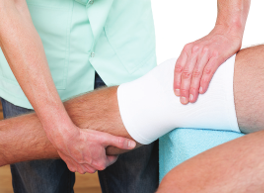
Arthrofibrosis, also known as “stiff knee syndrome,” occurs when excessive scar tissue forms around a joint, limiting range of motion and causing pain and disability. It can be a complication of knee replacement or anterior cruciate ligament surgery, with infections and bleeding as known contributing factors. Of the roughly 720,000 knee replacements performed every year in the United States, arthrofibrosis occurs after approximately 6% of these surgeries.
The longer your knee remains immobile after surgery, the greater your chance of developing this condition. If you recently underwent knee replacement surgery, you need to remember that some subsequent knee stiffness is normal and may not be a sign of arthrofibrosis. Arthrofibrosis is usually characterized by the following symptoms:
- Walking with a bent knee. Inability to straighten your knee or difficulty contracting your quadriceps muscles may be signs of stiffness and the development of arthrofibrosis.
- Worsening pain in the knee. In the weeks and months after surgery, pain should decrease gradually. Increasing pain may be a sign of arthrofibrosis.
- Warmth and swelling around the knee. While these are often common after knee surgery, see your physician if they persist, because they, too, may signal the development of this painful condition.
Mild cases of arthrofibrosis may be resolved with intensive physical therapy alone. Other treatments include manipulation under anesthesia, when a physician manipulates the knee in a controlled fashion to break up the scar tissue. Surgery may also be an option for some patients.
Regardless of the course of treatment, physical therapy will play an important role. We will work with you to restore your range of motion with passive stretching and manual mobilization techniques. If your physician decides that surgery is the best course of treatment, we will work with you for six to eight weeks after surgery to maintain the range of motion gained with the surgery and keep inflammation under control.
As you pursue treatment, be sure to call our office so we can work with you and your physician to help regain your range of motion and resume your daily activities without pain or stiffness.









